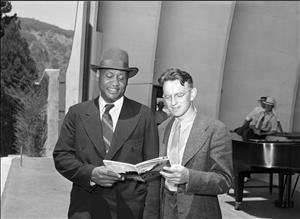Seattle-born activist and musician Earl H. Robinson is remembered for writing some of the labor movement's most famous ballads, including "I Dreamed I Saw Joe Hill Last Night." Robinson attended West Seattle High School and the University of Washington. He traveled to New York in 1934 to join the WPA Federal Theater Project. His patriotic themes expressed a strong sympathy for the working class and for ordinary citizens. They earned him the friendship of Eleanor Roosevelt and Paul Robeson, Hollywood movie commissions, and a right-wing blacklisting in the 1950s. Robinson was "rediscovered" during the folk music revival of the 1960s. He returned to Seattle and his roots in 1989 to pursue more abstract compositions. He died in a car accident near his West Seattle home on July 20, 1991.
Don't Mourn, Harmonize
I dreamed I saw Joe Hill last night,
Alive as you and me.
Says I, "But, Joe, you're ten years dead,"
"I never died," says he,
"I never died," says he.
Few have failed to be moved by those words, whether hearing them from the liquid thunder of baritone Paul Robeson, the oboe lament of Joan Baez, or the slender tenor of the composer of the music, Earl Robinson. In fact, Robinson's musical legacy probably turns on Joe Hill, the Industrial Workers of the World organizer who told supporters, "Don't mourn, organize!" shortly before his 1915 execution by a Utah firing squad. Robinson remembered clearly the writing of Joe Hill in 1936. "I was directing the music in a left-wing summer camp, Camp Unity near Wingdale, NY. We decided to put on a campfire program of Joe Hill songs. Alfred Hayes gives me this lyric in the afternoon. I went into the tent with the lyric and came out 45 minutes later with the tune. I want it that night."
From West Seattle to New York
Robinson was born in Seattle on July 2, 1910. As a child he studied piano, violin, and viola. He graduated from West Seattle High School in 1928. He was inducted into the school's Hall of Fame in 1987. From 1929 to 1933, he attended the University of Washington, studying composition. Unable to find work as a music teacher, he moved to New York in 1934, where he joined the Workers Laboratory Theater, a WPA Federal Theater Project, and the Composers Collective of the Pierre Degeyter Club.
Earl studied with Aaron Copland at the Downtown Music School, and with Hanns Eisler, a German émigré composer. He wrote and co-wrote many topical songs, of which "Joe Hill," "Abe Lincoln," "The House I Live In," and "Hurry Sundown" are perhaps the most famous. "Black and White" also achieved great popularity, selling more than a million copies as recorded by Three Dog Night.
Red, White & Blue, But Mostly Red
Robinson's cantatas set the tone for a genre of patriotic composition. Most notable was Ballad for Americans, first performed on radio in 1939 with the great Paul Robeson as soloist, and The Lonesome Train. He twice received a Guggenheim Fellowship. Franklin and Eleanor Roosevelt welcomed Robinson to the White House (and he established a friendship with Eleanor) in the 1940s while the FBI had him under surveillance. Ballad for Americans was the theme song at both Republican and Communist Party national conventions in 1940. In 1947, a documentary starring Frank Sinatra called The House I Live In won an Academy Award.
In the mid-1940s, and then in the 1960s, following a blacklisting that stemmed from his association with the Communist Party, Robinson worked in Hollywood on film scores, The House I Live In, A Walk in the Sun, The Roosevelt Story, California, Romance of Rosy Ridge, among others. In the mid-1950s, he chaired the music department at Elisabeth Irwin High School in New York City.
Robinson's later works became more abstract. He wrote concertos for banjo and piano. His works for the stage include ballets, musicals, and folk operas on a wide range of subjects: Irish tunnel workers, immigrant Jews, ancient Armenia, dolphins, the lost city of Atlantis. In his last years he turned to spiritual and ecological themes, including Jesus and St. Francis. From his early labor songs in the 1930s to elegiac tributes to Paul Robeson in the 1980s, Robinson's songs were inextricably entwined with the leftist folk musicians of the century: Joan Baez, Woody Guthrie, Paul Robeson, Carl Sandburg, and Pete Seeger.
In 1989, Robinson moved back to his family home in West Seattle. With mayoral and gubernatorial proclamations, he performed before a joint session of the state legislature. A revue of his music at the Pioneer Square Theatre paid tribute to his life and work. His last concerts included the Worker's Heritage Festival at Fort Worden, the observance of Seattle Library's Centennial, and the Seattle Folklife Festival. On the evening of July 20, 1991, Robinson was killed in a head-on auto collision on Southwest Admiral Way in West Seattle.
In a videotaped interview in 1990, he said, "I would like to be remembered as a composer of good songs – songs that help people." Robinson's life and work illustrate how music can transcend class, ethnic, and generational boundaries. As a creator of popular culture, he brought together old and young, passing on the collective memory and inspiring new generations through songs of hope. Perhaps nothing sums up the composer's spirit so well as the critic Joe Adcock's assessment of a Robinson revue in Seattle:
"Elegantly turned-out songs of hope, courage, loyalty, humor, justice, gratitude and generosity are worth celebrating. A rebirth and renewal of these qualities is passionately to be desired. And two hours of effective adult entertainment that doesn't exploit hatred and fear is a rare and joyous experience."

